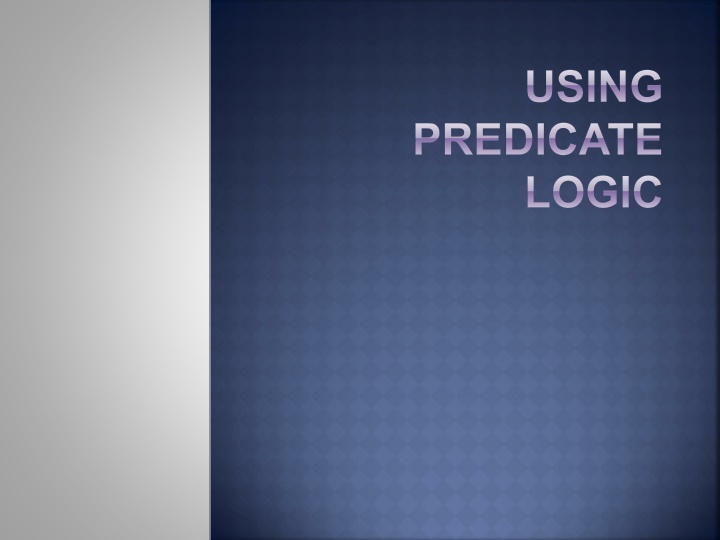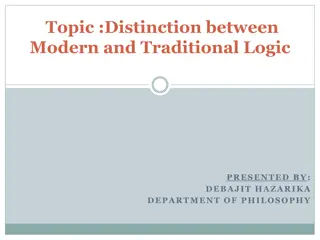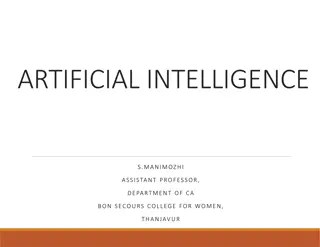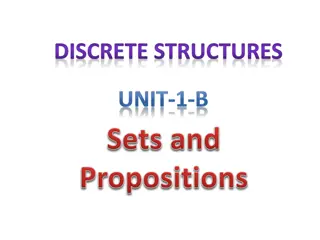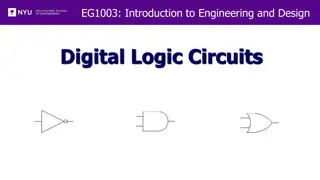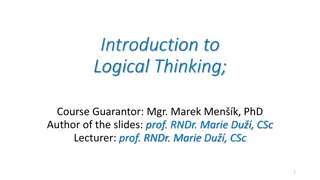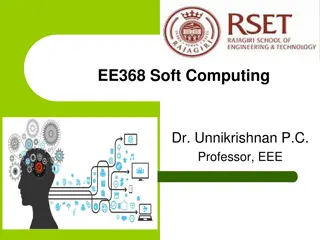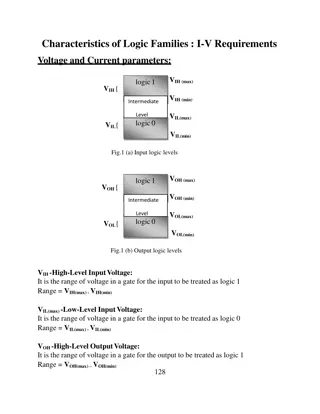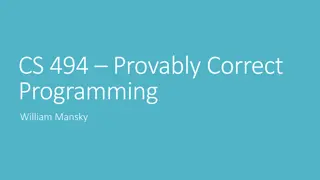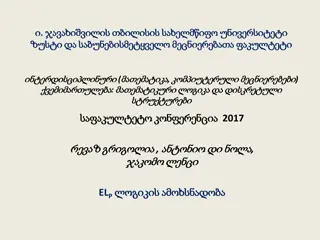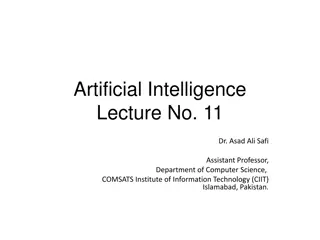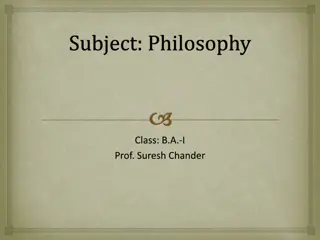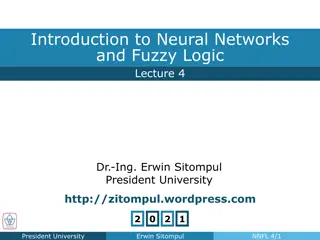Representation of Facts in Logic
Demonstrating the use of Propositional and Predicate Logic to represent simple facts and relationships in a structured manner. Explore how logical statements are used to model real-world scenarios and aid in reasoning processes. Address key challenges in converting English sentences into logical statements and discuss important issues related to ambiguity and inference.
Uploaded on Apr 20, 2025 | 6 Views
Download Presentation

Please find below an Image/Link to download the presentation.
The content on the website is provided AS IS for your information and personal use only. It may not be sold, licensed, or shared on other websites without obtaining consent from the author.If you encounter any issues during the download, it is possible that the publisher has removed the file from their server.
You are allowed to download the files provided on this website for personal or commercial use, subject to the condition that they are used lawfully. All files are the property of their respective owners.
The content on the website is provided AS IS for your information and personal use only. It may not be sold, licensed, or shared on other websites without obtaining consent from the author.
E N D
Presentation Transcript
USING PREDICATE LOGIC
REPRESENTING SIMPLE FACTS IN LOGIC Demonstrating the use of Propositional logic Simple to deal with and decision procedure exist. Real world facts can be represented as logical propositions written as well formed formulas(wff s) in propositional logic It is raining. RAINING It is sunny. SUNNY It is Windy WINDY It is raining then it is not sunny RAINING-> SUNNY Problems with propositional logic Consider the statement Socrates is a man represented as SOCRATESMAN Pluto is a man represented as PLUTOMAN Both are separate assertion and cannot draw any conclusion about similarities If these facts are represented as MAN(SOCRATES) MAN(PLUTO). Now the structure of representation reflects the structure of knowledge. We should apply predicates to arguments 1. 2.
REPRESENTING SIMPLE FACTS IN LOGIC If the statement All men are Mortal is represented as MORTALMAN Fails to capture the relationship between any individual being a man and individual being Mortal. Predicate Logic Represents real world facts as statements written in wffs If knowledge is represented as logical statements then we can reason with that knowledge. It does not have a decision procedure but has a procedure that will find a solution to proposed theorem so it is semi decidable. It is useful in representing and manipulating some of the kinds of knowledge that AI system might need. Example: Marcus was a man- man(Marcus) Marcus was a pompeian.-Pomopeian(Marcus) 1. 2.
REPRESENTING SIMPLE FACTS IN LOGIC 3. All Pompeians were Romans- x: pompeian(x)->Roman(x) 4. Caesar was a ruler- ruler(Caesar) 5. All Romans were either loyal to Caesar or hated him.- x:Roman(x)->loyalto(x,Caesar) hate(x,Caesar) 6. Everyone is loyal to someone- x:->y:loyalto(x,y) 7. People only try to assassinate rulers they are not loyal to. x: y:person(x) ^ruler(y) ^tryassasinate(x,y)-> loyalto(x,y) 8. Marcus tried to assassinate Caesar- tryassasinate(Marcus,Caesar)
REPRESENTING SIMPLE FACTS IN LOGIC Was Marcus loyal to Caesar? :man(x) person(x)
REPRESENTING SIMPLE FACTS IN LOGIC Three important issues that must be addressed in the process of converting English sentences to logical statements Many English are ambiguous. There is a choice among representation. Simple representations are desirable, but they may prevent certain kinds of reasoning. Even in simple situations a set of sentences may not contain all the necessary information. Another problem is we do not know in advance is which statement to deduce For example for the question Was Marcuse loyal to Caesar? Which one to prove Loyalto(Marcus,Caesar) Loyalto(Marcus,Caesar) 1. 2. 3.
REPRESENTING INSTANCE AND ISA RELATIONSHIP Instance(Marcus,man) Instance(marcus,pompeian) x:instance(x,pompeian) instance(x,Roman) Instance(Caesar,ruler) x:instance(x,Roman) loyalto(x,Caesar) hate(x,Caesar) 1. 2. 3. 4. 5. Instance(Marcus,man) Instance(marcus,pompeian) Isa(pompeian,Roman) Instance(Caesar,ruler) x:instance(x,Roman) loyalto(x,Caesar) hate(x,Caesar) x: y: z:instance(x,y) isa(y,z) instance )x,z) 1. 2. 3. 4. 5. 6.
REPRESENTING INSTANCE AND ISA RELATIONSHIP The class and super class memberships need not always be represented with the predicates Isa and instance, instead unary predicates corresponding to class can be used. There are several ways a fact can be represented within a particular representational frame work. But within a knowledge base consistency of representation is critical. The inference mechanisms are not just important because of inference of superclass memberships but because it permits inference of properties associated with the membership in that superclass. If an exception has to be added then the old assertions has to be changed otherwise the knowledge base will be inconsistent. Example for Exception : Pompeian(Paulus) [loyalto(Paulus,Caesar) hate(Paulus,Caesar)] Changes in corresponding assertion x: Roman(x) eq(x,Paulus) loyalto(Paulus,Caesar) hate(Paulus,Caesar)
COMPUTABLE FUNCTIONS AND PREDICATES If the number of facts are very large then it cannot be represented as individual predicates Example: greater than and less than relationships of numbers Gt(1,0) Gt(2,1) .. lt(0,1 ), lt(1,2) . In such cases it is useful to have computable predicates where a procedure can be invoked which will evaluate and return true and false. Examples for conflict and their resolution 1. All Pompeians died when the volcano erupted in 79 A.D Erupted(volcano,79) ^ x:[Pompeian(x) died(x,79) ] 2. No Mortal lives longer than 150 years x: t1: t2:mortal(x) born(x,t1) gt(t2-t1,150) dead(x,t2) 3. It is now 1991 Now=1991 // example of equality 4. Alive means not dead x: t :[alive(x,t) dead(x,t) ]^ [ dead(x,t) alive(x,t) ] 5. If someone is dead he is dead at all later times x: t1: t2:diedd(x,t1) ^ gt(t2,t1) -> dead(x,t2)
FACTS Is Marcus Alive?
COMPUTABLE FUNCTIONS AND PREDICATES Observations: Even a very simple conclusion may require many steps to prove. A variety of processes such as matching, substitution and application of modus ponens are involved in the production of a proof.
RESOLUTION Resolution is a procedure that operates on statements that have been converted to a very convenient standard form. Resolution produces proofs by refutation- proves a statement by showing that its negation is a contradiction with the given statements. Suppose we know that all Romans who know Marcus either hate Caesar or think that anyone who hates anyone is crazy. We could represent that in the following wff: x: [Roman(x) know(x, Marcus)] [hate(x, Caesar) V ( y : z : hate (y, z) thinkcrazy(x, y))] To use this formula in a proof requires a complex matching process. The formula would be easier to work with if It were flatter, i.e., there was less embedding of components . The quantifiers were separated from the rest of the formula so that they did not need to be considered.
RESOLUTION CONT.. Conjunctive normal form [Davis and Putnam, 1960] has both of these properties. For example, the formula x: [Roman(x) know(x, Marcus)] [hate(x, Caesar) V ( y : z : hate (y, z) thinkcrazy(x, y))] would be represented in conjunctive normal form as Roman(x) know(x, Marcus) hate(x, Caesar) hate(y, z) thinkcrazy(x, z) We need to reduce a set of wff's to a set of clauses, where a clause is defined to be a wff in conjunctive normal form but with no instances of the connector A
RESOLUTION CONT.. Algorithm: Convert to Clause Form 1. Eliminate using the fact that a b is equivalent to a V b. Performing this transformation on the wff given above yields x: [Roman(x) know(x, Marcus)] V [hate(x, Caesar) V ( y : ( z : hate(y, z)) V thinkcrazy(x, y))] 2. Reduce the scope of each to a single term, using the fact that ( p) = p DeMorgan's laws : (a b) = a V b and (a V b) = a b ] The standard correspondences between quantifiers : x: P(x) = x: P(x) x: P(x) = x: P(x) Performing this transformation on the wff from step 1 yields x: [ Roman(x) V know(x, Marcus)] V [hate(x, Caesar) V ( y: z: hate(y, z) V thinkcrazy(x, y))]
RESOLUTION CONT.. ALGORITHM: CONVERT TO CLAUSE FORM CONT.. 3. Standardize variables so that each quantifier binds a unique variable x: P(x) V x: Q(x) would be converted to x: P(x) V y: Q(y) 4. Move all quantifiers to the left of the formula without changing their relative order x: y: z: [ Roman(x) V know(x, Marcus)] V [hate(x, Caesar) V ( hale(y, z) V thinkcrazy(x, y))] At this point, the formula is in what is known asprenex normal form. It consists of a prefix of quantifiers followed by a matrix, which is quantifier-free.
RESOLUTION CONT.. ALGORITHM: CONVERT TO CLAUSE FORM CONT.. 5. Eliminate existential quantifiers. A formula that contains an existentially quantified variable asserts that there is a value that can be substituted for the variable that makes the formula true. We can eliminate the quantifier by substituting for the variable a reference to a function that produces the desired value. Since we do not necessarily know how to produce the value, we must create a new function name for every such replacement. for example, the formula y : President(y) can be transformed into President(S1) where S1 is a function with no arguments that somehow produces a value that satisfies President. If existential quantifiers occur within the scope of universal quantifiers, then the value that satisfies the predicate may depend on the values of the universally quantified variables. For example, in the formula x: y: father-of(y, x) transformed into x: father-of(S2(x), x) These generated functions are called Skolem functions. Sometimes ones with no arguments are called Skolem constants.
RESOLUTION CONT.. ALGORITHM: CONVERT TO CLAUSE FORM CONT.. 6. Drop the prefix. At this point, all remaining variables are universally quantified, so the prefix can be dropped Now the formula produced in step 4 appears as [ Roman(x) V know(x, Marcus)] V [hate(x, Caesar) V ( hate(y, z) V thinkcrazy(x, y))] 7. Convert the matrix into a conjunction of disjuncts. In the our example, there are no and s, so simply remove the parentheses, giving Roman(x) V know(x, Marcus) V hate(x, Caesar) V hate(y, z) V thinkcrazy(x, y) Here we can exploit the associative property (a b) V c = (a V c) (b c)] or the distributive property- (a b) V c = (a V c) (b V c)] For example, the formula (winter wearingboots) V (summer wearingsandals) becomes, after one application of the rule [winter V (summer wearingsandals)] [wearingboots V (summer wearingsandals)] and then, after a second application, required since there are still conjuncts joined by OR's, (winter V summer) (winter V wearingsandals) (wearingboots V summer) (wearingboots V wearingsandals)
RESOLUTION CONT.. ALGORITHM: CONVERT TO CLAUSE FORM CONT.. 8. Create a separate clause corresponding to each conjunct. In order for a wff to be true, all the clauses that are generated from it must be true. If there are several wff s, all the clauses generated by each of them can now be combined to represent the same set of facts as were represented by the original wff's. 9. Standardize apart the variables (rename the variables so that no two clauses make reference to the same variable). In making this transformation, the following fact can be used ( x: P(x) Q(x)) = x: P(x) x: Q(x) Thus since each clause is a separate conjunct and since all the variables are universally quantified, there need not be a relationship between the variables of two clauses, even if they were generated from the same wff. After applying this entire procedure to a set of wff's, we will have a set of clauses, each of which is a disjunction of literals.
RESOLUTION CONT.. THE BASIS OF RESOLUTION The resolution procedure is a simple iterative process At each step, two clauses, called the parent clauses, are compared yielding a new clause that has been inferred from them. The new clause represents waysthat the two parent clauses interact with each other. Suppose that there are two clauses in the system: winter V summer winter V cold From this we can deduce summer V cold (Resolvent) If the clause that is produced is the empty clause, then a contradiction has been found. For example, the two clauses winter winter The theoretical basis of the resolution procedure in predicate logic is Herbrand's theorem [Chang and Lee, 1973J, which tells us the following: To show that a set of clauses S is unsatisfiable, it is necessary to consider only interpretations over a particular set, called the Herbrand universe of S. A set of clauses S is unsatisfiable if and only if a finite subset of ground instances (in which all bound variables have had a value substituted for them) of S is unsatisfiable
RESOLUTION CONT.. RESOLUTION IN PROPOSITIONAL LOGIC In propositional logic, the procedure for producing a proof by resolution of proposition P with respect to a set of axioms F is the following. Algorithm: Propositional Resolution 1 Convert all the propositions of F to clause form. 2. Negate P and convert the result to clause form. Add it to the set of clauses obtained in step 1. 3. Repeat until either a contradiction is found or no progress can be made: (a) Select two clauses. Call these the parent clauses. (b) Resolve them together. The resulting clause, called the resolvent, will be the disjunction of all of the literals of both of the parent clauses with the following exception: If there are any pairs of literals L and L such that one of the parent clauses contains L and the other contains L, then select one such pair and eliminate both L and L from the resolvent. (c) If the resolvent is the empty clause, then a contradiction has been found. If it is not, then add it to the set of clauses available to the procedure.
RESOLUTION CONT.. RESOLUTION IN PROPOSITIONAL LOGIC Example: we want to prove R First we convert the axioms to clause form, as shown in the second column Then we negate R, producing R
THE UNIFICATION ALGORITHM In predicate logic, this matching process is more complicated since the arguments of the predicates must be considered. For example, man(John) and man(John) is a contradiction, while man(John) and man(Spot) is not. Thus, in order to determine contradictions, a matching procedure is needed that compares two literals and discovers whether there exists a set of substitutions that makes them identical. The unification algorithm, is a straightforward recursive procedure that does this. The basic idea If the initial predicate symbols are the same we can proceed. Otherwise, they cannot be unified. Example- tryassassinate (Marcus, Caesar) hate(Marcus, Caesar) If the predicate symbols match, then we must check the arguments, one pair at a time.
RESOLUTION CONT.. THE UNIFICATION ALGORITHM The matching rules:- Different constants or predicates cannot match; identical ones can. A variable can match another variable, any constant, or a predicate expression, with the restriction that the predicate expression must not contain any instances of the variable being matched. There must be a single, consistent substitution for the entire literal . Each substitution that is found should be applied it to the remainder of the literals before we continue trying to unify them. For example, suppose we want to unify the expressions 1. P(x, x) 2. P(y, z) if y is substituted for x y/x then 1. P(y, y) 2. P(y, z) attempt to unify arguments y and z, which succeeds with the substitution z/y The entire unification process has now succeeded with a substitution that is the composition of the two substitutions . The composition is written as In general, the substitution (a1/a2, a3/a4, )(b1/b2, b3/b4, ) means to apply all the substitutions of the right- most list, then take the result and apply all the ones of the next list, and so forth, until all substitutions have been applied. Try to unify f(x, x) and g(x),g(x)) (z/y)(y/x)
RESOLUTION CONT.. THE UNIFICATION ALGORITHM The objective of the unification procedure is to discover at least one substitution that causes two literals to match procedure Unify(L1 , L2), returns as its value a list representing the composition of the substitutions that were performed during the match The empty list, NIL, indicates that a match was found without any substitutions. The list consisting of the single value FAIL indicates that the unification procedure failed. Algorithm: Unify(L1, L2) I. If L1 or L2 are both variables or constants, then: (a) If L1 and L2 are identical, then return NIL. (b) Else if L1 is a variable, then if L1 occurs in L2 then return {FAIL}, else return (L2/L1). (c) Else if L2 is a variable, then if L2 occurs in L1 then return {FAIL}, else return (L1/L2). (d) Else return {FAIL}. 2. If the initial predicate symbols in L1 and L2 are not identical, then return {FAIL}. 3. If LI and L2 have a different number of arguments, then return {FAIL}. 4. Set SUBST to NIL.
RESOLUTION CONT.. THE ALGORITHM UNIFY CONTINUES For i 1 to number of arguments in L1 : (a) Call Unify with the ith argument of L1 and the ith argument of L2, putting result in S. (b) If S contains FAIL then return {FAIL}. (c) If S is not equal to NIL then: (i) Apply S to the remainder of both L1 and L2. (ii) SUBST: = APPEND(S, SUBST). 6. Return SUBST.
RESOLUTION CONT.. RESOLUTION IN PREDICATE LOGIC Two literals are contradictory- if one of them can be unified with the negation of the other. , for example, man(x) and man(Spot) are contradictory. For example. suppose we want to resolve two clauses: 1. man(Marcus) 2. man(x1) V mortal(x1) Substitution Marcus/x Resolvent mortal(x1) The resolution process can then proceed from there to discover whether mortal(Marcus) leads to a contradiction with other available clauses.
RESOLUTION CONT.. ALGORITHM RESOLUTION 1. Convert all the statements of F to clause form. 2. Negate P and convert the result to clause form. Add it to the set of clauses obtained in 1. 3. Repeat until either a contradiction is found , no progress can be made, or a predetermined amount of effort has been expended. (a) Select two clauses. Call these the parent clauses. (b) Resolve them together. The resolvent will be the disjunction of all the literals of both parent clauses with appropriate substitutions performed and with the following exception: If there is one pair of literals T1 and T2 such that one of the parent clauses contains T2 and the other contains T1 and if T1 and T2 are unifiable, then neither T1 nor T2 should appear in the resolvent. We call T1 and T2 Complementary literals. Use the substitution produced by the unification to create the resolvent. If there is more than one pair of complementary literals, only one pair should be omitted from the resolvent. (c) If the resolvent is the empty clause, then a contradiction has been found. If it is not, then add it to the set of clauses available to the procedure.
RESOLUTION CONT.. RESOLUTION IN PREDICATE LOGIC strategies for making the choice that can speed up the process considerably: Only resolve pairs of clauses that contain complementary literals, To facilitate this, index clauses by the predicates they contain, combined with an indication of whether the predicate is negated. Eliminate certain clauses as soon as they are generated so that they cannot participate in later resolutions. Two kinds of clauses should be eliminated: tautologies (which can never be unsatisfied) and clauses that are subsumed by other clauses (i.e., they are easier to satisfy. For example, P V Q is subsumed by P.) Whenever possible, resolve either with one of the clauses that is part of the statement we are trying to refute or with a clause generated by a resolution with such a clause. This is called the set-of-support strategy and corresponds to the intuition that the contradiction we are looking for must involve the statement we are trying to prove. Any other contradiction would say that the previously believed statements were inconsistent. Whenever possible, resolve with clauses that have a single literal. Such resolutions generate new clauses with fewer literals than the larger of their parent clauses and thus are probably closer to the goal of a resolvent with zero terms. This method is called the unit-preference strategy.
Resolution proof of the statement hate(Marcus,Caesar)
RESOLUTION CONT.. RESOLUTION IN PREDICATE LOGIC Did Marcus hate Caesar? If the previous proof was an answer to the above question then we could even prove hate(Marcus, Caesar) then we should add hate(Marcus, Caesar but there are no clause to create a contradiction. But sometimes these contradictions are identified at a later stage. For example
RESOLUTION CONT.. RESOLUTION IN PREDICATE LOGIC If the knowledge base contains two additional statements 9. persecute(x, y) hate(y, x) 10. hate(x, y) persecute(y, x) Converting to clause form, we get 9. persecute(x5, y2) V hate(y2, x5) 10. hate(x6, y3) V persecute (y3, x6) Although resolvents can be generated new ones cannot be generated.
RESOLUTION CONT.. RESOLUTION IN PREDICATE LOGIC Example showing the need to standardize variables if clause 2 had been rewritten as mother(a, b) V woman(a) Then the clause father(Chris, y) will be produced and the contradiction with clause 4 would have emerged
Example demonstrates two ways of generating new clauses, in addition to the resolution rule: 1. Substitution of one value for another to which it is equal. 2. Reduction of computable predicates
hate(Marcus, Paulus) hate(Marcus, Julian) RESOLUTION CONT.. NEED TO TRY SEVERAL SUBSTITUTIONS
RESOLUTION CONT.. QUESTION ANSWERING Resolution can be used to answer fill-in-the-blank questions, such as "When did Marcus die?" or "Who tried to assassinate a ruler? To answer the question as "When did Marcus die?" we need a statement like died(Marcus, ??) i.e died(Marcus, 79) answer will be 79. In order to be able to answer this question, it must first be true that Marcus died. Thus it must be the case that t: died(Marcus, t) A reasonable first step then might be to try to prove this. To do so using resolution, we attempt to show that t: died(Marcus, i) produces a contradiction. which means it conflicts with a statement of the form t: died(Marcus, t) where t is a variable, in which case we can either answer the question by reporting that there are many times at which Marcus died, or we can simply pick one such time and respond with it
Answer extraction using resolution Adding an expression that we are trying to prove
RESOLUTION CONT.. QUESTION ANSWERING There are some questions that cannot be answered using this mechanism. For example, suppose that we want to answer the question "What happened in 79 A.D.? In order to answer the question, we need to prove that something happened in 79. We need to prove x: event(x, 79) and to discover a value for x. But we do not have any statements of the form event(x, y). However, the question can be answered ,if we change our representation from erupted(volcano, 79) to event(erupted(volcano), 79) Drawback 1. It is more complex. 2. It still does not make it possible to answer all conceivable questions
NATURAL DEDUCTION Disadvantages of resolution Since everything looks the same, there is no easy way to select those statements that are the most likely to be useful in solving a particular problem. In converting everything to clause form, we lose valuable heuristic information that is contained in the original representation of the facts. For example, suppose we believe that all judges who are not crooked are well-educated, which can be represented as x: judge(x) crooked(x) educated(x) In this form, the statement suggests a way of deducing that someone is educated. But when the same statement is converted to clause form judge(x) V crooked(x) V educated(x) people do not think in resolution Machine theorem proving that corresponds more closely to the processes used in human theorem proving is defined as natural deduction. It describes a method in which various techniques are used in combination to solve problems that are not tractable by any one method alone. One common technique is to arrange knowledge, not by predicates but rather by the objects involved in the predicates. 1. 2. 3.
